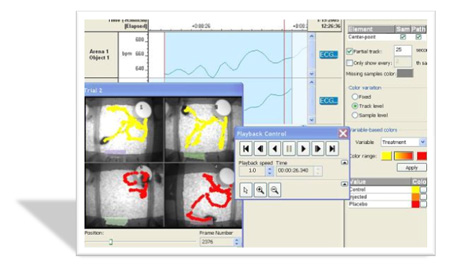Telemetry
Ethovision Behavioral Tracking System
The behavioral tracking and the telemetry systems are available for IACUC approved investigators. For more information about the IACUC and the related facility please visit http://www.research.usf.edu/cm/.
EthoVision XT is an advanced video tracking system for automatic recording of activity, movement, and social interaction of animals in just about any enclosure. Besides tracking of the animal's body center, EthoVision XT offers tracking of the nose point and tail base point of rats and mice. Providing a wide range of features for video tracking and data analysis, EthoVision allows for automation of a wide range of behavioral tests, including:
- Novel object recognition test
- Social interaction test
- Morris water maze test
- Porsolt swim test
- Tests with 96-well plate
EthoVision can further be extended with various accessories to perform behavioral experiments or to support the collection of behavioral data.
Your questions can be answered by Rex
DSI Implantable Telemetry System
Scientists are able to study a number of physiological parameters in laboratory mice using DSI PhysioTel Transmitters using different implantable transmitters to measure different parameters including pressure and activity; temperature and activity; biopotentials and activity; as well as transmitters that measure a combination of pressure, biopotentials, temperature and activity.
DSI implantable telemetry transmitters are used in studies involving mice such as telemetric recordings of sleep and home cage activity, abnormal heart rate and body temperature in mice lacking thyroid hormone receptor x1, the effects of triiodothyronine on heart rate, and numerous other studies.
All of DSI’s PhysioTel Transmitters are implantable and capable of measuring activity. The design of the transmitter shape allows for subcutaneous or intraperitoneal placement and PhysioTel transmitters can be re-sterilized between uses, extending their implant life.
PhysioTel implantable telemetry transmitters provide the most cost-effective and efficient method of measuring physiologic parameters in conscious, freely moving laboratory animals. Virtually any laboratory animal can be, and has been, monitored using DSI telemetry products.
Physiologic data collection using telemetry has many advantages over older, traditional methods of data collection such as restraints, cuffs and tethers. In some cases, anesthesia is still used in obtaining physiologic data. However, the anesthesia itself may affect the data being collected. Telemetry eliminates the need for such data collection methods and provides researchers with data that are free from stress-induced artifact and the effects of anesthesia.
With questions please contact: Charles Szekeres, PhD at kszekere@usf.edu.

